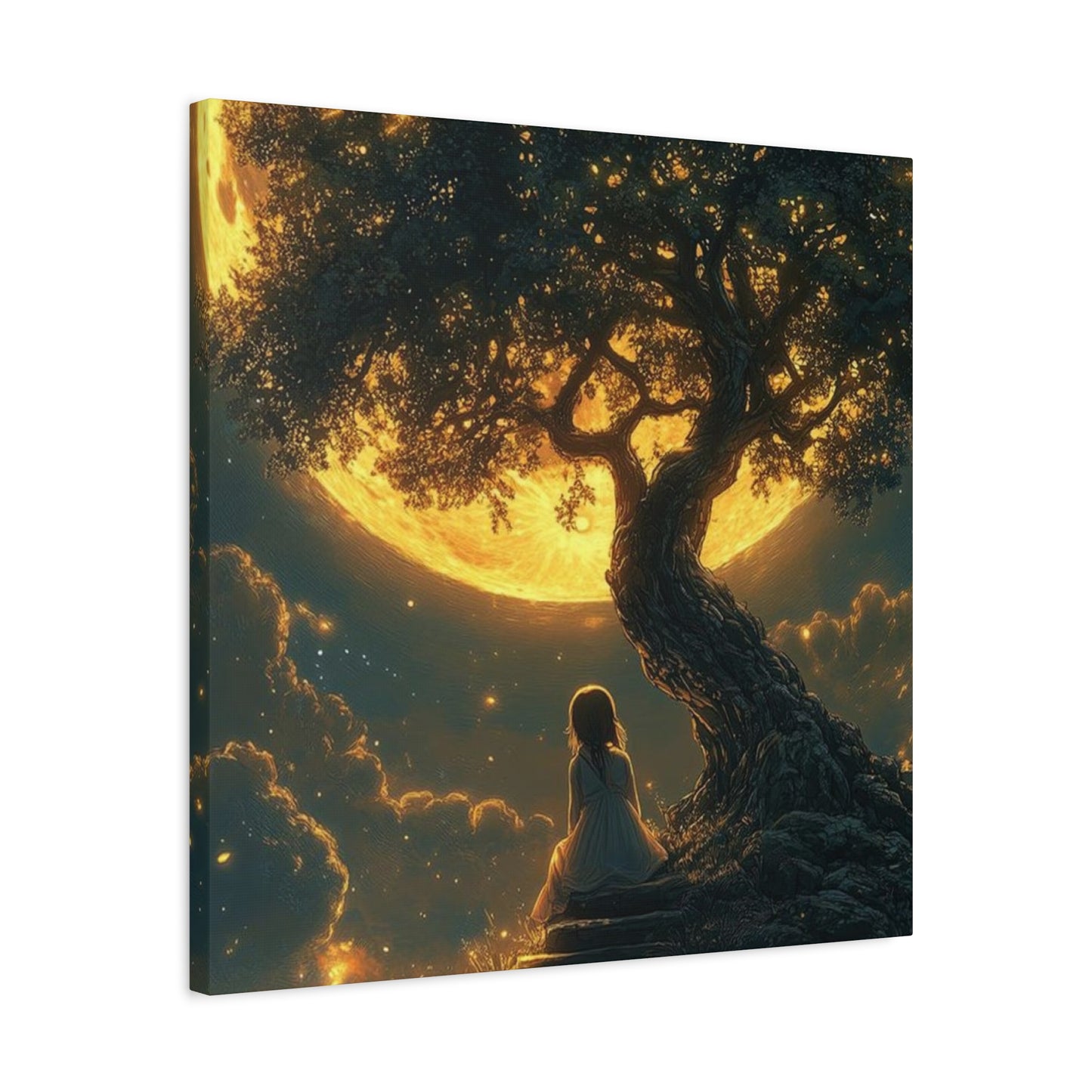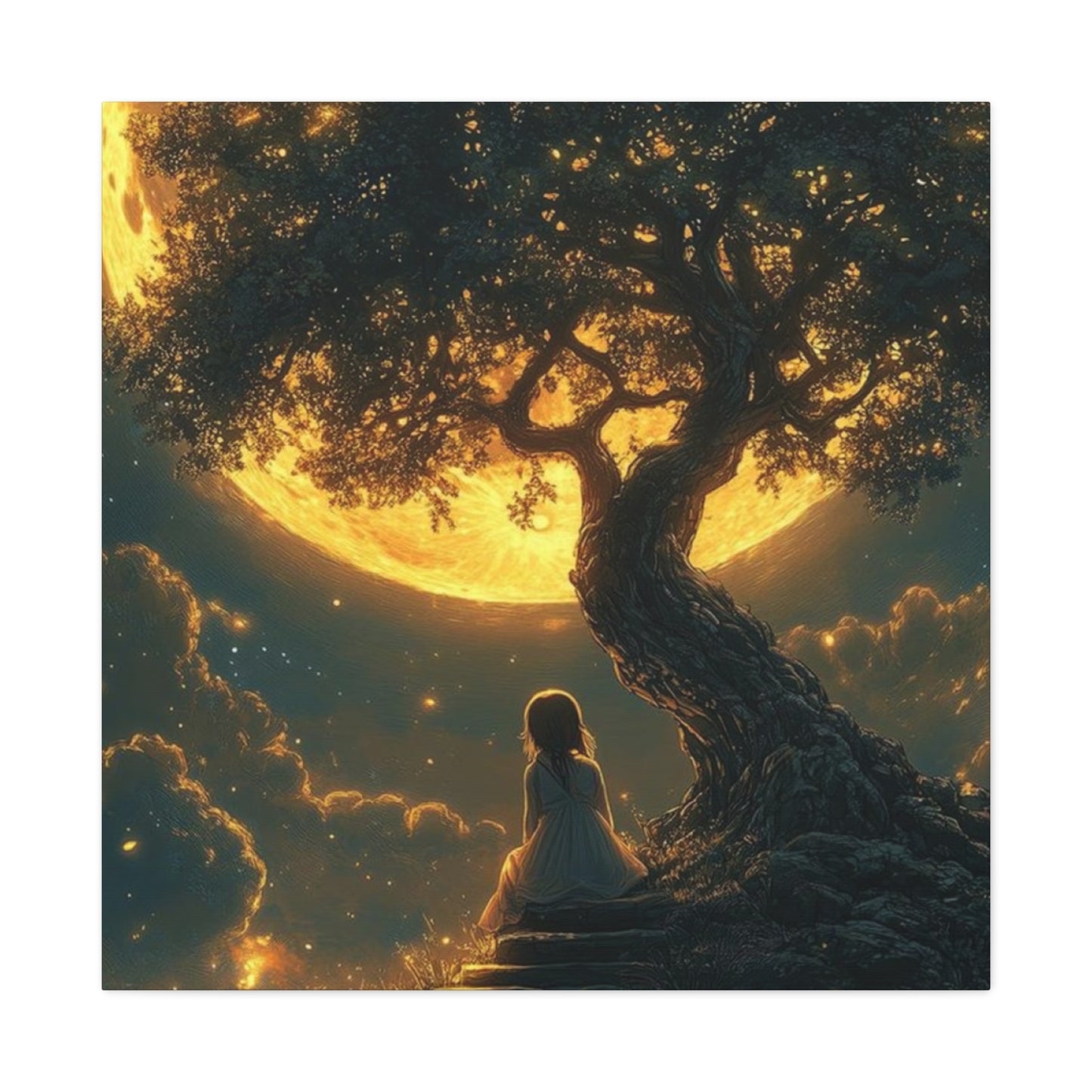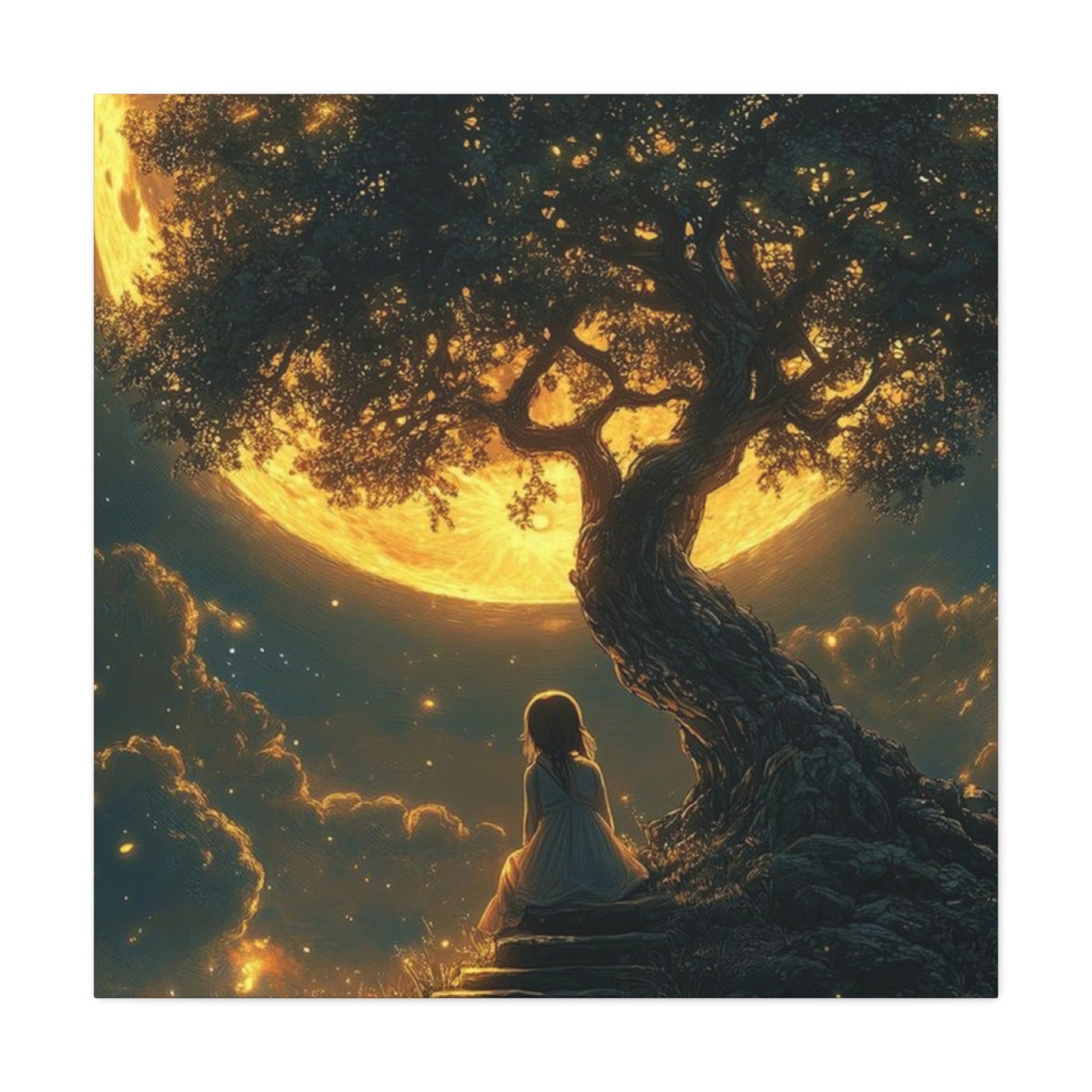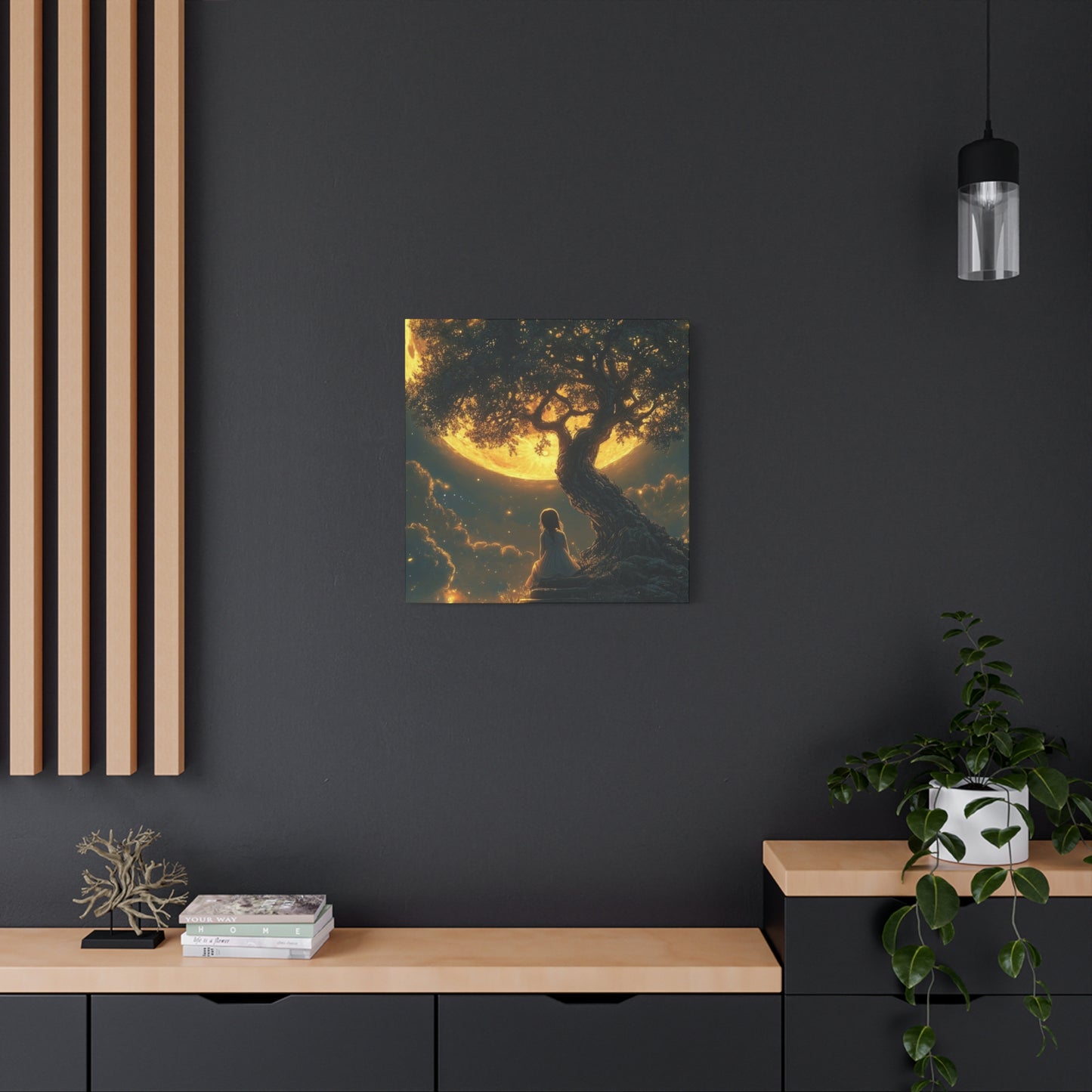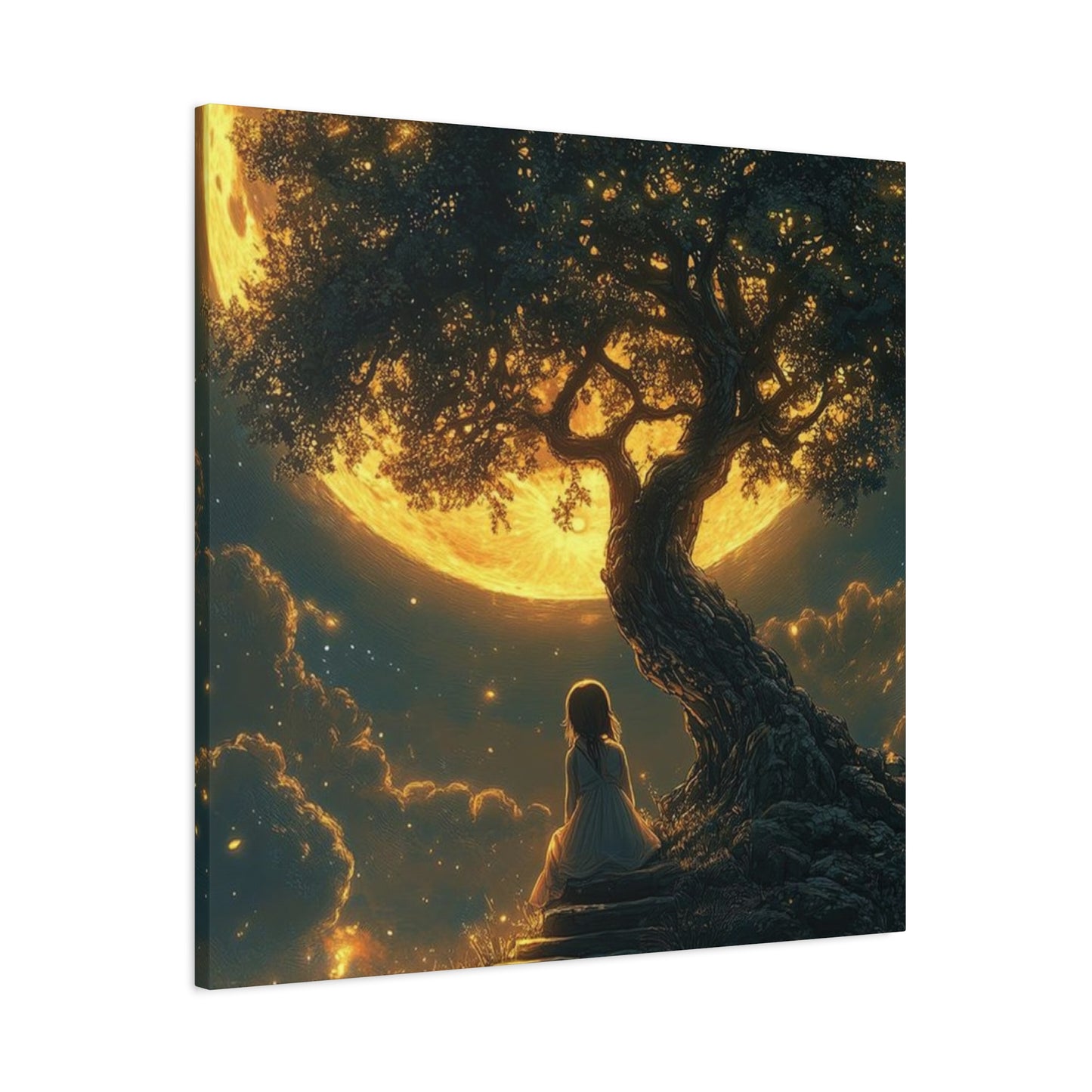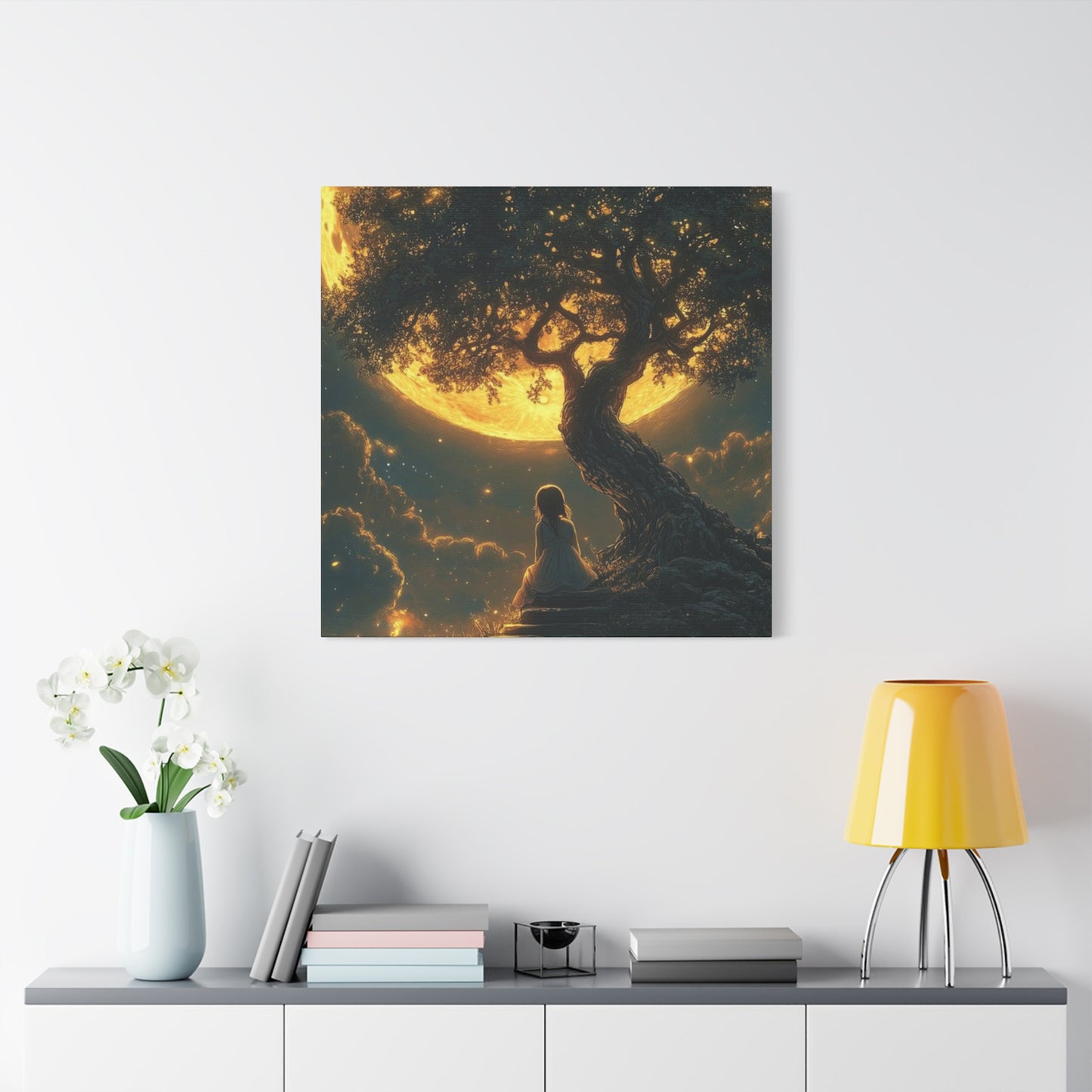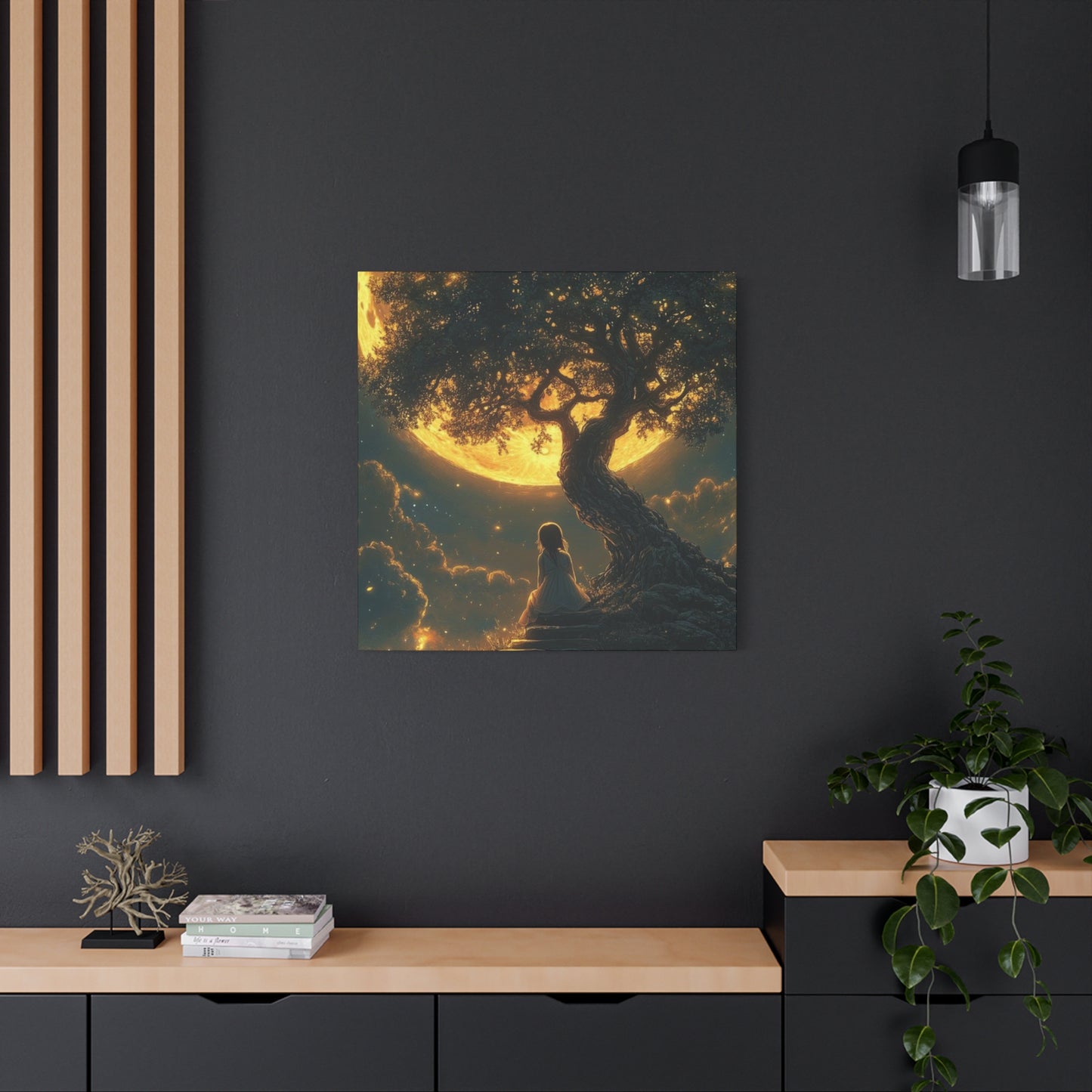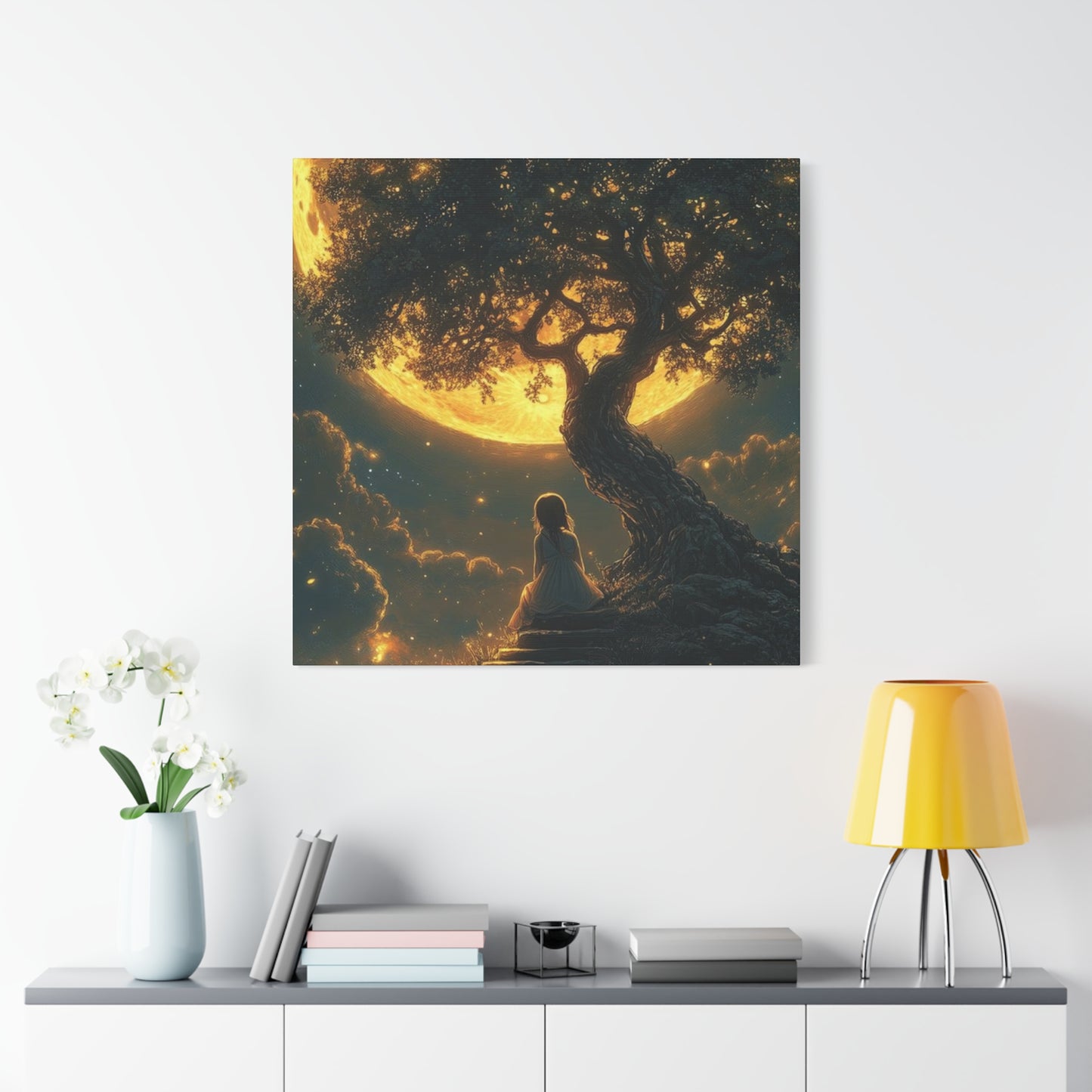Yellow Moonrise Fantasy Wall Art: Creating Enchanting Spaces with Celestial Design Elements
The allure of celestial imagery has captivated human imagination for millennia, and among the most mesmerizing representations is the golden lunar ascent against twilight skies. This particular aesthetic combines the warmth of amber hues with the mystical quality of nocturnal landscapes, creating visual narratives that transform ordinary living spaces into realms of wonder and contemplation. The growing popularity of this decorative approach reflects a deeper cultural yearning for connection with natural phenomena and the timeless beauty of astronomical events.
When considering interior decoration that incorporates lunar themes, the selection of color palettes becomes paramount. The golden yellow spectrum evokes feelings of optimism, creativity, and spiritual awakening, while simultaneously maintaining the ethereal quality associated with moonlight. This chromatic choice distinguishes itself from traditional silver or white lunar depictions, offering instead a warmer, more inviting atmospheric quality that complements a variety of interior design philosophies.
The artistic representation of moon phases during their ascent over imaginary or stylized landscapes provides endless creative possibilities. Artists working within this genre often blend realistic astronomical details with fantastical elements, creating compositions that feel simultaneously grounded in natural observation and liberated by imaginative interpretation. This balance between reality and fantasy allows such artwork to serve as both decorative elements and conversation starters, inviting viewers to project their own narratives and emotional responses onto the imagery.
The Cultural Significance of Lunar Imagery in Contemporary Design
Throughout human history, lunar symbolism has carried profound cultural and spiritual significance across diverse civilizations. The moon has represented fertility, transformation, intuition, and the passage of time in countless mythologies and belief systems. Contemporary interior design that incorporates these celestial elements taps into this rich symbolic vocabulary, allowing individuals to surround themselves with imagery that resonates on both conscious and subconscious levels.
The specific choice of golden or amber coloration for lunar representations connects to ancient associations between the moon and harvest cycles. In agricultural societies, the harvest moon and hunter's moon were celebrated for their unusual brightness and color, which appeared more yellow or orange due to atmospheric conditions during certain times of year. Modern interpretations of these natural phenomena allow urban dwellers to maintain symbolic connections to seasonal cycles and agrarian traditions that may no longer play direct roles in their daily lives.
Eastern philosophical traditions have long emphasized the importance of harmony between interior spaces and natural elements. The incorporation of celestial imagery, particularly representations of lunar cycles, aligns with principles found in various design philosophies that seek to create balanced, spiritually nourishing environments. The golden moonrise motif specifically bridges the energetic qualities of solar warmth with the reflective, contemplative nature of lunar energy, creating a visual representation of balance and duality.
Western esoteric traditions similarly ascribe significant meaning to lunar symbolism, often associating the moon with the subconscious mind, dreams, and hidden knowledge. Decorative choices that feature prominent lunar imagery can serve as daily reminders to honor intuitive wisdom and creative processes. The fantasy elements often incorporated into these designs further emphasize the connection between lunar symbolism and the realm of imagination, dreams, and possibility.
Artistic Techniques in Fantasy Landscape Composition
The creation of compelling fantasy landscapes requires mastery of numerous artistic techniques that combine observational accuracy with imaginative interpretation. Successful compositions balance realistic elements that ground the viewer's perception with fantastical features that transport them beyond everyday experience. In moonrise-themed artwork, this often involves rendering the lunar body with careful attention to light and shadow while populating the surrounding landscape with elements that could not exist in physical reality.
Atmospheric effects play crucial roles in establishing mood and depth within these compositions. Artists manipulate color temperature, value contrast, and edge definition to create the illusion of space and atmosphere. The golden glow of a rising moon naturally creates opportunities for dramatic backlighting, silhouetting foreground elements while casting warm highlights on clouds and mist. These lighting conditions allow for striking compositions that emphasize shape and form while suggesting rather than explicitly defining details.
The incorporation of fantastical architectural elements has become a hallmark of this artistic genre. Impossible towers, floating islands, and structures that defy conventional physics populate many such compositions, their forms often inspired by diverse architectural traditions ranging from Gothic European cathedrals to Asian pagodas and Middle Eastern minarets. These elements serve multiple functions: they provide scale reference for the celestial body, create visual interest through silhouette and form, and suggest narrative possibilities that engage viewer imagination.
Water features appear frequently in moonrise compositions, offering opportunities for reflection effects that double the visual impact of the lunar presence. Whether depicted as calm lakes perfectly mirroring the sky, turbulent seas with waves catching golden highlights, or cascading waterfalls that seem to flow from impossible heights, water adds movement and life to otherwise static compositions. The reflective qualities of water surfaces also allow artists to repeat and emphasize their primary light source, reinforcing the luminous quality that defines the genre.
Selecting Appropriate Spaces for Celestial Artwork
The placement of large-scale decorative pieces significantly affects their impact and the overall atmosphere of a room. Fantasy moonrise artwork typically demands sufficient viewing distance to be appreciated fully, making it most suitable for spaces with adequate wall area free from visual clutter. Living rooms, master bedrooms, and dedicated meditation or creative spaces often provide ideal venues for such statement pieces, where they can serve as focal points around which other decorative elements are arranged.
Lighting considerations become paramount when displaying artwork featuring luminous subjects. Natural light sources can either enhance or detract from the piece depending on their intensity and direction. South-facing walls in northern hemisphere locations receive indirect natural light that won't create problematic glare but will properly illuminate the artwork during daylight hours. Artificial lighting should be chosen carefully to complement rather than overwhelm the piece's inherent luminosity; adjustable spotlights or picture lights allow for customization based on time of day and desired ambiance.
The relationship between artwork scale and room dimensions requires careful consideration. Oversized pieces can overwhelm small spaces, while modestly sized works may appear lost on expansive walls. A general principle suggests that artwork should occupy roughly sixty to seventy-five percent of available wall space above furniture pieces, though this guideline flexes according to personal preference and specific room characteristics. Fantasy moonrise compositions, with their emphasis on expansive skies and distant horizons, often benefit from generous sizing that allows viewers to feel immersed in the depicted scene.
Complementary decorative elements should enhance rather than compete with celestial-themed artwork. Furniture selections might echo the warm golden tones present in the piece or provide cool contrasts that make the warm hues appear even more vibrant. Textile choices including curtains, throw pillows, and area rugs can either harmonize with the artwork's palette or provide deliberate counterpoints. The goal remains creating a cohesive environment where the artwork feels integrated rather than arbitrarily placed.
Digital Versus Traditional Media in Fantasy Art Creation
The evolution of digital art tools has revolutionized fantasy art creation, offering capabilities that would be prohibitively time-consuming or simply impossible using traditional media alone. Digital painting software allows artists to work in layers, making experimental approaches and revisions far less risky than when working with physical paint. The ability to adjust color balance, value relationships, and compositional elements after initial execution provides tremendous creative freedom, enabling artists to refine their visions through iterative processes.
Despite these advantages, traditional media retains distinct qualities that many artists and collectors prize. Physical paint exhibits textures, luminosities, and imperfections that contribute to a work's unique character and presence. The tactile quality of brushstrokes, the occasional drip or spatter, and the subtle variations in pigment application all create visual interest at close viewing distances that digital reproductions struggle to replicate. Limited edition prints of traditionally created works often command premium prices precisely because they originated as unique physical objects.
Hybrid approaches combining traditional and digital techniques have become increasingly common, allowing artists to leverage the strengths of both methodologies. An artist might create an initial composition using traditional sketching and painting, then scan the work for digital enhancement, color correction, and the addition of effects difficult to achieve manually. Alternatively, digital preliminary work might inform a traditionally executed final piece, with color studies and compositional experiments conducted digitally before committing to canvas or paper.
The choice between digital and traditional media affects not only the creation process but also the final product's characteristics. Digital artworks exist primarily as files that can be reproduced endlessly without degradation, making them ideal for mass-market decorative prints. Traditional works are inherently unique or exist in small, numbered editions, appealing to collectors who value exclusivity and the romance of owning something hand-created. Both approaches have legitimate places in contemporary art markets, serving different needs and price points.
Framing and Presentation Options for Maximum Impact
The framing and mounting of decorative artwork significantly influences its visual impact and perceived value. For moonrise fantasy pieces emphasizing atmosphere and luminosity, frame selections should enhance rather than distract from the imagery itself. Simple frames in metallic finishes that echo the golden tones within the composition create cohesive presentations, while darker wood frames can provide elegant contrast that makes lighter elements appear more luminous by comparison.
Matting decisions require consideration of the specific artwork's characteristics. Generous mat borders create breathing room around compositions, preventing them from feeling cramped or overwhelmed by frames. However, edge-to-edge framing without mats creates more immersive effects, eliminating visual barriers between viewer and depicted scene. For moonrise compositions with important elements extending to the edges, minimal or no matting may prove most effective. Conversely, works with central focus points benefit from mat borders that draw the eye inward.
Glass or acrylic glazing protects artwork from environmental damage while affecting its appearance and cost. Standard glass provides adequate protection at reasonable prices but creates reflections that can interfere with viewing under certain lighting conditions. Non-reflective or museum glass eliminates most glare through special coatings, dramatically improving visibility but significantly increasing cost. Acrylic alternatives offer shatter resistance and lighter weight but scratch more easily than glass, requiring more careful handling.
Alternative presentation methods beyond traditional framing have gained popularity in contemporary interior design. Canvas gallery wraps, where printed imagery extends around thick wooden frames, create modern, casual presentations suitable for contemporary spaces. Metal prints offer extraordinary luminosity and color saturation, particularly effective for subjects featuring glowing celestial bodies and atmospheric effects. Wood-mounted prints provide organic, textural presentations that complement rustic or nature-inspired decor schemes.
The Role of Scale and Perspective in Immersive Artwork
Artists creating moonrise fantasy compositions manipulate scale relationships to generate emotional responses and guide viewer perception. Oversized moons looming impossibly large over landscapes create dreamlike qualities that immediately signal departure from realistic representation. This deliberate distortion serves multiple purposes: it emphasizes the moon's importance as the composition's primary subject, creates dramatic visual impact, and generates the sense of wonder central to fantasy aesthetics.
Foreground, middle ground, and background elements must be carefully orchestrated to create convincing depth despite the inclusion of impossible elements. Artists employ atmospheric perspective, reducing contrast and color saturation for distant elements while maintaining sharp definition and strong values in foreground features. This mimics natural visual perception, helping viewers unconsciously accept the spatial relationships presented even when logical analysis would reveal their impossibility.
The positioning of the lunar body within the composition frame significantly affects mood and narrative suggestion. Low-horizon placements with the moon just beginning its ascent create anticipatory feelings and suggest transition from day to night. Higher placements with substantial sky above the celestial body offer opportunities for cloud formations and atmospheric effects while creating more balanced, meditative compositions. Centered moons draw direct attention and create formal, symmetrical arrangements, while off-center placements generate dynamic tension and directional movement within the frame.
Human or animal figures included in these compositions serve crucial functions in establishing scale and inviting narrative interpretation. A solitary figure contemplating the moonrise encourages viewer identification and suggests themes of solitude, contemplation, or spiritual seeking. Groups of figures might indicate celebration, pilgrimage, or shared wonder. The deliberate absence of any figures creates mysterious, possibly post-apocalyptic or pre-human atmospheres that allow viewers to imagine themselves as the first witnesses to these impossible vistas.
Incorporating Mythological and Symbolic Elements
Many contemporary fantasy moonrise compositions incorporate symbolic elements drawn from diverse mythological traditions, creating layered works that reward careful observation and contemplation. Dragons circling distant peaks, phoenixes silhouetted against golden luminosity, or ethereal spirits emerging from mists all add narrative depth while connecting to archetypal imagery that resonates across cultural boundaries. These inclusions transform simple landscape studies into visual storytelling vehicles that engage viewers' imaginations.
Architectural elements in these compositions frequently reference sacred structures from various cultural traditions, suggesting spiritual or mystical themes. Temples, shrines, monuments, and ceremonial spaces appear often, their presence implying that the depicted moonrise holds special significance. The choice of architectural style communicates cultural context even when other landscape features remain deliberately ambiguous. A Gothic cathedral suggests European medieval settings, while tiered pagodas evoke East Asian contexts, and ziggurat forms reference ancient Mesopotamian civilizations.
Plant life in fantasy moonrise compositions often includes both recognizable and impossible species. Familiar trees and flowers ground the scene in natural reality, while impossible blooms, luminous foliage, or gigantic proportions signal the fantasy elements. Willow trees appear frequently, their drooping branches creating elegant silhouettes and suggesting melancholy or contemplative moods. Cherry blossoms and other flowering species add delicate beauty and reference specific cultural associations, particularly Japanese aesthetic principles emphasizing transient beauty.
Celestial phenomena beyond the primary moon often appear in these compositions, including multiple moons, visible planets, shooting stars, or nebular formations impossible to see with naked eyes from Earth's surface. These additions emphasize the fantastical nature of the depicted world while creating additional points of luminosity that balance compositions and guide viewer attention. The presence of impossible astronomical features immediately establishes that the depicted realm operates under different physical laws than our own reality.
Creating Cohesive Gallery Walls with Celestial Themes
The growing popularity of gallery wall arrangements offers opportunities to create narrative sequences or thematic collections featuring moonrise and celestial imagery. Rather than relying on a single large statement piece, gallery walls combine multiple smaller works to cover substantial wall areas, creating dynamic, personalized displays that evolve over time. Cohesive celestial-themed galleries might trace lunar phases, depict moonrises over different fantasy landscapes, or combine lunar imagery with complementary astronomical and natural subjects.
Successful gallery walls require careful planning regarding arrangement, spacing, and visual balance. Templates can be created using paper cutouts taped to walls, allowing experimentation with configurations before committing to hanging hardware. Common organizational principles include symmetrical grids for formal, orderly effects; salon-style asymmetrical arrangements for casual, collected-over-time aesthetics; or horizontal lines at consistent heights for modern, streamlined appearances. Celestial galleries particularly suit salon arrangements that can suggest constellations or celestial maps through their spatial relationships.
Frame consistency versus variety presents a key decision point in gallery wall creation. Matching frames in identical sizes create uniform, calming presentations that emphasize the artwork itself over the framing. Mixed frames in various sizes and styles generate more energetic, eclectic presentations suitable for personal, collected aesthetics. For celestial themes, consistent metallic frames in gold, bronze, or copper tones can unify diverse images while reinforcing the warm, glowing qualities characteristic of moonrise imagery.
Lighting gallery walls effectively requires attention to each individual piece while maintaining overall illumination balance. Track lighting systems with adjustable heads allow for customization, directing focused light where needed while avoiding glare on glazed surfaces. LED strip lighting mounted above or below gallery arrangements provides even ambient illumination without the hot spots created by individual fixtures. The goal remains creating visibility without overpowering the inherent luminosity often central to celestial-themed artwork.
Seasonal Considerations and Rotating Displays
Interior decoration increasingly embraces seasonal rotation, allowing living spaces to reflect changing natural cycles and maintaining visual freshness throughout the year. Moonrise fantasy artwork lends itself particularly well to autumn and winter displays, when earlier sunsets make twilight and nocturnal scenes feel especially relevant. The golden amber tones characteristic of many moonrise compositions harmonize beautifully with autumn color palettes, while the mystical qualities suit the introspective moods often associated with darker seasons.
Spring rotations might replace moonrise scenes with dawn-themed compositions, maintaining celestial connections while shifting toward lighter, more energetic color palettes. Summer displays could emphasize bright daylight scenes or nocturnal images featuring star fields and galaxies rather than prominent lunar subjects. This cyclical approach prevents decorative fatigue while allowing collections to grow and evolve, with each piece receiving featured display time during its most appropriate season.
Storage solutions for artwork not currently displayed require careful consideration to prevent damage. Acid-free tissue paper should separate stacked pieces, with cardboard corners protecting frames from chipping. Climate-controlled environments prevent warping from humidity fluctuations and fading from temperature extremes. Vertical storage systems that prevent pieces from leaning at angles reduce frame stress and make retrieval easier when rotation time arrives. Careful inventory tracking ensures that all pieces receive regular display opportunities.
Seasonal rotation practices offer practical advantages beyond aesthetic refreshment. By limiting any single piece's light exposure, fading and deterioration slow considerably, extending artwork longevity. Insurance considerations may also benefit from rotation, as artwork in storage faces fewer risks than displayed pieces vulnerable to accidents, theft, or environmental damage. The anticipation of seasonal changes can itself become a source of enjoyment, with decoration adjustments marking the passage of time and creating opportunities for intentional engagement with living spaces.
The Influence of Asian Aesthetic Principles on Lunar Art
Eastern artistic traditions, particularly those originating in China, Japan, and Korea, have profoundly influenced contemporary fantasy moonrise imagery. The concept of capturing essential spirit rather than photographic accuracy aligns perfectly with fantasy art's imaginative approach. Traditional East Asian landscape painting emphasizes suggestion over explicit detail, using minimal brushstrokes to evoke rather than define forms. This economical approach creates atmospheric, contemplative compositions that have inspired countless contemporary digital and traditional artists working in fantasy genres.
The Japanese aesthetic principle of yugen, suggesting profound grace and subtle beauty with hints of sadness, frequently appears in moonrise compositions. This quality emerges through mist-shrouded landscapes, partially obscured moons, and compositions that leave significant areas undefined, inviting viewer contemplation. The related concept of ma, or meaningful emptiness, influences compositional choices that incorporate substantial negative space, allowing depicted elements to breathe and creating visual rest areas that prevent compositions from feeling cluttered.
Chinese landscape painting traditions established conventions including high viewpoints that allow simultaneous viewing of near and distant elements, creating impossible but compelling spatial relationships. Contemporary fantasy artists frequently employ these elevated perspectives, allowing moonrise scenes to encompass vast territories from foreground shores or cliffs through middle-ground valleys or seas to distant mountain ranges where celestial bodies emerge. This comprehensive approach creates immersive environments that reward extended viewing.
The East Asian artistic emphasis on seasonal awareness and natural cycles connects deeply with lunar imagery's inherent symbolism. Traditional moon-viewing customs, particularly the Japanese tsukimi and Chinese Mid-Autumn Festival, celebrate the autumn moon's particular beauty, creating cultural contexts that enrich contemporary artistic interpretations. Artists familiar with these traditions can incorporate subtle references that add layers of meaning for informed viewers while maintaining accessibility for those unaware of specific cultural contexts.
Beyond Residential Decoration
While residential decoration represents the primary market for fantasy moonrise artwork, numerous commercial applications exist for this imagery. Hospitality venues including hotels, resorts, and spas frequently employ calming, atmospheric artwork to create welcoming environments that encourage relaxation. Moonrise scenes with their inherent tranquility and beauty serve these functions excellently, particularly in luxury establishments seeking to create distinctive, memorable atmospheres that differentiate them from competitors.
Wellness facilities including yoga studios, meditation centers, and therapy offices benefit from celestial imagery's spiritual associations and calming visual qualities. The symbolism of lunar cycles connecting to personal transformation and renewal aligns with the services these establishments provide. Large-scale moonrise murals or prominent canvas prints serve as focal points for meditation practices while establishing the contemplative, introspective atmosphere appropriate to these spaces.
Restaurant and bar environments employ atmospheric artwork to establish mood and enhance thematic concepts. Fantasy tavern or inn themes particularly suit moonrise imagery, while upscale cocktail bars might use sophisticated, minimalist lunar compositions to create elegant ambiance. The warm golden tones characteristic of many moonrise pieces complement candlelight and low-level interior lighting typical of dining establishments, creating cohesive environments where all design elements reinforce the intended atmosphere.
Corporate spaces have begun incorporating more imaginative, inspiring artwork as awareness grows regarding workplace environment's impact on employee satisfaction and productivity. Companies in creative industries particularly benefit from fantasy artwork that stimulates imagination and signals organizational values emphasizing innovation and thinking beyond conventional boundaries. Conference rooms, creative department spaces, and common areas offer appropriate venues for moonrise compositions that provide contemplative focal points without the aggressive energy associated with more dynamic imagery.
Print Production Technologies and Quality Considerations
The reproduction quality of fantasy artwork for decorative purposes depends heavily on production technology selections. Giclée printing, utilizing archival inks and fine art papers or canvas, produces museum-quality reproductions with exceptional color accuracy and longevity. The term giclée derives from French meaning to spray or squirt, referencing the inkjet technology employed. These prints can last decades or even centuries under proper conditions, making them suitable for serious collectors and premium markets.
Direct-to-substrate printing technologies allow for reproduction on diverse materials including wood panels, metal sheets, and acrylic blocks. Each material imparts distinct visual characteristics; metal prints exhibit extraordinary luminosity and color saturation particularly suited to glowing moonrise subjects, while wood prints create organic, textural presentations with visible grain patterns adding character. These alternative substrates often eliminate framing requirements, reducing costs and creating contemporary presentations suitable for modern interiors.
Color management throughout the production chain critically affects final print quality. Monitors must be calibrated to industry standards ensuring that colors viewed digitally accurately predict final print appearance. Printer profiling matches specific ink, paper, and printer combinations, creating precise relationships between digital files and physical outputs. Without proper color management, disappointing results frequently occur, with prints appearing too dark, exhibiting incorrect color casts, or lacking the vibrancy present in original digital files.
Paper and canvas selections significantly influence print character and longevity. Acid-free fine art papers prevent yellowing and deterioration over time, essential for archival quality. Cotton rag papers offer superior longevity and luxurious textures compared to wood-pulp alternatives. Canvas weights and weaves affect draping characteristics when stretched over frames and influence visible texture in final presentations. Coatings including matte, satin, and gloss finishes alter reflectivity and color appearance, with each option offering distinct advantages depending on lighting conditions and personal preferences.
Customization Options and Personalized Artwork
The increasing accessibility of digital art tools has created opportunities for customized fantasy artwork tailored to individual preferences and specific interior design requirements. Working with artists on commissioned pieces allows for exact size specifications, color palette adjustments to match existing decor, and incorporation of meaningful personal elements. The ability to specify whether compositions should be vertical, horizontal, or square format ensures optimal fit for intended display locations.
Some artists offer semi-custom approaches where existing compositions receive modifications based on client requests. This might include adjusting color temperatures from warm golden tones to cooler blues, adding or removing architectural elements, or changing foreground details while maintaining the overall composition. These limited customizations typically cost less than fully original commissions while still providing personalization beyond mass-produced options.
Digital customization tools available through various online platforms allow consumers to make certain adjustments themselves before ordering prints. Size scaling, cropping to different aspect ratios, and sometimes basic color adjustments can be performed without artist involvement. While these self-service options lack the refinement possible through artist collaboration, they provide immediate results and budget-friendly personalization.
Photographic elements can sometimes be incorporated into fantasy moonrise compositions, creating unique hybrid works that blend realistic personal imagery with fantastical environments. A photograph of a beloved pet, family member, or meaningful location might be seamlessly integrated into an existing fantasy landscape, creating deeply personal pieces with emotional significance far exceeding generic decorative art. These approaches require skilled digital manipulation to achieve convincing results where photographic and illustrated elements coexist harmoniously.
Maintaining and Preserving Decorative Artwork
Proper care extends the lifespan of decorative prints and original artwork, protecting investments and ensuring continued enjoyment. Light exposure represents the primary threat to print longevity, with ultraviolet radiation causing fading and color shifts over time. Archival inks and materials resist degradation better than standard products, but all artwork benefits from UV protection through specialized glazing, window films, or simply limiting direct sunlight exposure.
Environmental factors including temperature fluctuations, humidity extremes, and airborne pollutants all threaten artwork integrity. Consistent climate conditions prevent warping, prevent mold growth, and slow general deterioration. Locations near heating vents, air conditioning units, or exterior walls subject to significant temperature variations should be avoided when possible. Humidity control proves particularly important, with levels between forty and fifty percent considered ideal for most paper and canvas artwork.
Cleaning artwork requires gentle approaches that remove accumulated dust and grime without damaging surfaces or protective glazing. Soft, lint-free cloths gently wiped across glass or acrylic glazing remove most surface dust. Glass cleaners can be used on glazing but should never contact artwork directly. For unglazed canvas or paper works, extremely soft brushes designed specifically for artwork can remove surface dust, though professional conservation services should be consulted for works of significant value.
Frame maintenance ensures continued protection and attractive presentation. Wood frames benefit from occasional treatment with appropriate polishes or waxes that prevent drying and splitting. Metal frames require different products that clean without abrading finishes. Hardware including hanging wires, D-rings, and wall hooks should be inspected periodically, as failures can result in falling artwork and potential damage. Proper hanging with appropriate hardware for the artwork's weight prevents accidents and reduces frame stress.
Psychology of Fantasy and Escapism in Home Environments
The human need for escapism and imaginative stimulation has intensified in increasingly urbanized, technology-dominated contemporary life. Home environments serve as refuges from external pressures, and decorative choices that incorporate fantasy elements facilitate mental and emotional departure from everyday stresses. Moonrise imagery with its inherent tranquility and other-worldly beauty creates visual portals to imagined realms where quotidian concerns feel temporarily distant and irrelevant.
Research into environmental psychology has demonstrated that visual access to nature, even through artwork and images, provides measurable stress reduction and mood improvement. Fantasy nature scenes that maintain recognizable natural elements while adding impossible features provide these benefits while adding layers of engagement unavailable through purely realistic imagery. The cognitive stimulation of interpreting fantastical elements may enhance rather than diminish restorative effects by providing healthy distraction from rumination and worry.
The deliberate creation of dedicated spaces for contemplation, creativity, or relaxation benefits from environmental design that signals departure from utilitarian functionality. Fantasy artwork serves as one element in establishing these special zones where different mental states are encouraged. When combined with appropriate lighting, comfortable seating, and minimal distractions, these spaces become sanctuaries supporting mental health, creative work, and spiritual practices.
Personal identity expression through decorative choices allows individuals to externalize internal values, interests, and aspirations. Fantasy artwork selections communicate imagination, appreciation for beauty, spiritual inclinations, or artistic sensibilities. These non-verbal communications create environments that feel authentically personal rather than generically decorated, increasing attachment to home spaces and contributing to overall life satisfaction.
The Evolution of Fantasy Art Markets and Accessibility
Historical patterns in art collecting restricted ownership of original or high-quality reproduced artwork to wealthy elites with resources to commission or purchase unique pieces. The democratization of art through advancing reproduction technologies has fundamentally altered these patterns, making museum-quality reproductions available at price points accessible to middle-class consumers. This shift has created vast markets for decorative art while simultaneously raising questions about value, authenticity, and the nature of art itself.
Print-on-demand services have eliminated inventory requirements and financial risks previously associated with art reproduction and sales. Artists can offer their work as prints without upfront production costs, while consumers access unprecedented variety without manufacturers needing to predict and stockpile popular designs. This model particularly benefits niche genres including fantasy art, where diverse stylistic preferences mean individual designs appeal to smaller audience segments that nonetheless collectively represent substantial markets.
Digital distribution platforms connecting artists directly with consumers have disrupted traditional gallery systems, though established galleries maintain relevance through curation, authentication, and the provision of physical spaces where artwork can be experienced before purchase. Hybrid models combining online discovery with in-person viewing options serve contemporary consumers who appreciate digital convenience but desire physical confirmation before committing to significant purchases.
Social media's influence on art markets cannot be overstated, with platforms enabling artists to build audiences, receive immediate feedback, and sell directly to followers. Viral artwork can achieve wide recognition rapidly, creating opportunities for emerging artists while increasing competition for attention. The visual nature of social media particularly favors eye-catching fantasy art, though algorithms emphasizing engagement over quality create challenges in ensuring worthwhile work receives appropriate recognition.
Therapeutic Applications of Nature-Based Imagery
Healthcare environments increasingly incorporate nature imagery and biophilic design principles, recognizing measurable health benefits including reduced anxiety, lower blood pressure, and improved recovery rates. Fantasy nature scenes that maintain recognizable natural elements while adding imaginative features provide these therapeutic benefits while creating distinctive, memorable environments that differentiate facilities and reduce institutional atmospheres.
Art therapy practices sometimes employ fantasy imagery creation as therapeutic activities, allowing clients to express emotions, explore personal narratives, and engage in creative processes with inherent healing properties. While art therapy typically focuses on client-created work rather than consuming existing artwork, the presence of inspiring fantasy pieces in therapeutic environments can stimulate imagination and provide entry points for therapeutic discussions.
Meditation practices benefit from focal points that hold attention without creating conceptual distraction. Fantasy moonrise imagery serves this function effectively, with glowing celestial bodies providing natural attention anchors while the overall compositional tranquility supports rather than disrupts meditative states. The symbolism of lunar cycles and transitions between day and night adds thematic resonance to practices focused on personal transformation and spiritual development.
Dementia care facilities have found that appropriate artwork including nature scenes provides orientation cues, reduces agitation, and improves mood among residents. Familiar natural elements including trees, water, and celestial bodies activate long-term memories potentially preserved when recent memory fails. The slightly fantastical nature of some imagery may prove less problematic for dementia patients than might be assumed, as their relationship with consensus reality already involves ambiguity and interpretation.
Regional and Cultural Variations in Lunar Appreciation
Global cultural traditions demonstrate remarkable diversity in lunar symbolism and associated celebrations, though certain themes including femininity, cycles, and transformation appear across many societies. Understanding these cultural contexts enriches appreciation of contemporary fantasy art that draws upon diverse traditions. Chinese culture associates the moon with yin energy, femininity, and family reunion, with the Mid-Autumn Festival celebrating lunar beauty and family togetherness through moon cakes and lanterns.
Japanese lunar appreciation traditions including tsukimi date back over a thousand years, with observances involving moon viewing, poetry composition, and offerings to honor the autumn moon's particular beauty. Contemporary artists drawing on Japanese aesthetic traditions often incorporate elements referencing these cultural practices including viewing platforms, traditional architecture, and seasonal plants associated with autumn. These subtle inclusions create layered works that reward cultural knowledge while remaining accessible to uninformed viewers.
Islamic cultures have developed rich lunar symbolism given the lunar calendar's central role in religious observance. The crescent moon appears as a widely recognized symbol, while the moon's phases determine the timing of Ramadan and other significant religious periods. Fantasy artists working within or drawing upon Islamic cultural contexts might incorporate arabesque patterns, mosque architecture, or calligraphy alongside lunar imagery, creating distinctive visual vocabularies different from East Asian or European approaches.
Indigenous traditions from the Americas include diverse lunar associations with many tribes tracking time through lunar months and associating particular full moons with seasonal activities or natural phenomena. Names including Snow Moon, Flower Moon, and Hunter's Moon reflect these connections. Contemporary fantasy artists might reference these traditions through seasonal details, inclusion of native plants and animals, or stylistic choices reflecting indigenous artistic traditions.
Creating Narrative Sequences Through Multiple Pieces
Series approaches where artists create multiple related pieces exploring variations on themes or telling visual stories offer enhanced engagement compared to single standalone works. A moonrise series might depict the same fantasy landscape across different seasons, showing environmental and atmospheric changes while maintaining recognizable features. Alternatively, a series might follow lunar phases from new to full and back again, creating cyclical narratives with symbolic resonance.
Journey narratives told across multiple pieces might depict travelers progressing through fantasy landscapes toward distant destinations, with the moon serving as a constant presence marking their advancement. Such sequences invite viewers to construct their own stories explaining who the travelers might be, what motivates their journey, and what awaits at their destination. This interactive dimension transforms passive viewing into creative participation.
Complementary pairs exploring contrasts including day and night, summer and winter, or calm and storm create dynamic presentations where pieces comment upon and complete each other. The moonrise piece in such pairs might serve as the contemplative, peaceful counterpoint to a more dynamic daylight or storm scene. Displayed adjacently, these pairs create unified compositions while maintaining individual integrity.
Triptych and multi-panel formats allow single compositions to span multiple canvases or frames, creating impact through scale while breaking the image into distinct sections that can be arranged with spacing between them. This approach suits moonrise subjects particularly well when horizontal triptychs depict expansive landscapes where the moon appears in one panel while surrounding environment extends across others. The breaks between panels create rhythm and visual interest while allowing the complete composition to exceed sizes possible with single panels.
Children's Spaces and Age-Appropriate Fantasy Design
Designing children's rooms and spaces with fantasy moonrise imagery requires consideration of age-appropriateness and developmental impact. Younger children benefit from simpler compositions with clear focal points and cheerful color palettes, while adolescents might appreciate more complex, sophisticated imagery reflecting developing aesthetic sensibilities. The inherent gentleness of most moonrise scenes makes them appropriate across age ranges, though specific execution details should reflect the intended audience.
Educational opportunities exist in fantasy artwork that includes accurate celestial details alongside imaginative elements. Children can learn moon phases, atmospheric effects causing color variations, and basic astronomy concepts while simultaneously engaging with imaginative landscapes. This combination of education and entertainment creates value beyond pure decoration, supporting learning through environmental design.
Night-time anxiety represents a common childhood challenge that appropriate bedroom decoration might help address. Imagery depicting moonrise and twilight rather than full darkness acknowledges night while maintaining the security of remaining light. The warm golden tones characteristic of many moonrise pieces create comfort rather than fear. Glow-in-the-dark elements or subtle illumination incorporated into artwork can provide reassuring night lights without disrupting sleep.
As children develop and personal preferences emerge, involving them in decoration decisions including artwork selection fosters autonomy and creates emotional investment in their environments. Fantasy genres often appeal strongly to children and adolescents who maintain fluid boundaries between reality and imagination. Allowing young people to select preferred compositions within appropriate boundaries supports identity development and personal expression.
Conclusion
Yellow Moonrise Fantasy Wall Art is more than just a striking visual; it is an invitation to embark on a journey into the realms of enchantment and imagination. The celestial beauty of a golden moon rising over a mysterious landscape can transform a room into a space where dreams, mystery, and tranquility merge. Celestial design elements, like the vivid yellow moon, bring with them an otherworldly charm that captivates the senses and elevates the energy of any environment. When incorporated into your home décor, this type of art doesn’t just decorate—it creates an atmosphere that feels magical, peaceful, and full of wonder.
One of the most powerful aspects of Yellow Moonrise Fantasy Wall Art is its ability to transport you into a dreamlike, serene world. The moon has long been a symbol of mystery, reflection, and connection to the cosmos. When rendered in vibrant yellow hues, this classic celestial figure takes on a new dimension, infusing the artwork with warmth, optimism, and energy. The rich, golden tones of the moon create a sense of radiance that contrasts beautifully with darker, more subdued elements of the landscape. This balance between light and dark brings a sense of harmony to the piece, inviting the viewer to contemplate the mystical world beyond the earthly realm. Whether the moonrise is set against a tranquil forest, an open ocean, or a star-filled sky, the art fosters a sense of peace and awe that transports you to a world beyond the ordinary.
In interior design, celestial elements have an undeniable ability to evoke a sense of wonder and imagination. The Yellow Moonrise Fantasy Wall Art effortlessly captures this essence, transforming a simple wall into a captivating focal point. Whether placed in a living room, bedroom, or even a home office, the piece serves as a reminder of the vastness of the universe and the beauty of the unknown. The glowing yellow moon serves as both a visual anchor and a source of light, making it a perfect addition to any space in need of a calming yet uplifting touch. The warmth of the yellow tones creates an inviting, cozy atmosphere, while the moon’s radiance infuses the room with a sense of peaceful optimism.
This type of celestial wall art can easily complement a variety of interior styles, from bohemian to contemporary, rustic to modern. The celestial theme works beautifully with earthy textures like wood, linen, and stone, lending itself to cozy, organic spaces. It can also pair well with sleek, minimalist designs, where the moonrise becomes a striking contrast against white walls or metallic accents. Regardless of your aesthetic preferences, the art provides an undeniable focal point that sparks conversation and contemplation. Whether you are looking for a calming piece to create a relaxing bedroom ambiance or an eye-catching feature in your living room, Yellow Moonrise Fantasy Wall Art fits seamlessly into any design concept.
Beyond its aesthetic appeal, the symbolism behind celestial art is deeply rooted in human culture and imagination. The moon has been a subject of fascination and reverence for millennia, often associated with the rhythms of life, intuition, dreams, and the passage of time. The moonrise is a powerful symbol of new beginnings, hope, and the cyclical nature of existence. By incorporating a Yellow Moonrise piece into your home, you bring not only a visually beautiful element but also an enduring symbol of positivity and possibility. The warm, golden hues evoke feelings of happiness, clarity, and renewal, making it an ideal choice for those seeking to infuse their living space with uplifting energy.
The Yellow Moonrise Fantasy Wall Art also offers a chance to escape from the mundane and connect with something larger than ourselves. In today’s fast-paced world, where stress and chaos are all too common, the idea of a peaceful moonrise can provide a much-needed reprieve. The art encourages us to pause, breathe, and reflect. It invites us to find beauty and peace in the stillness of the night sky, reminding us that there is magic in the moments of quiet wonder that often go unnoticed. This sense of calm is particularly effective in spaces meant for relaxation and rest—like bedrooms and meditation areas—where the Yellow Moonrise art can help promote mindfulness and tranquility.
In addition to its emotional and aesthetic impact, celestial art such as Yellow Moonrise Fantasy Wall Art also offers a rich opportunity for storytelling and personal connection. It can reflect the viewer’s own dreams, aspirations, and experiences with the night sky, serving as a reminder of the infinite possibilities that lie beyond the horizon. The moon, in its various phases, can symbolize personal growth, transformation, and hope. By adding this art to your space, you invite not just the beauty of the cosmos into your home, but also a sense of connection to something larger and more profound.
In conclusion, Yellow Moonrise Fantasy Wall Art is the perfect choice for anyone seeking to create a space filled with enchantment, calm, and beauty. Its celestial theme invokes a sense of wonder and imagination, turning any room into a serene sanctuary. The yellow moon’s warmth and radiance provide an uplifting focal point that works harmoniously with a range of interior styles, while its deeper symbolism encourages reflection and introspection. This artwork serves as a visual reminder of the mysteries of the universe and the magic that exists in our everyday lives. Whether you’re drawn to its peaceful aura, its vibrant energy, or its connection to the cosmos, the Yellow Moonrise Fantasy piece is sure to elevate your space and bring a touch of celestial enchantment into your home.

















